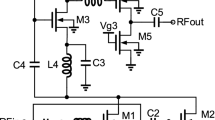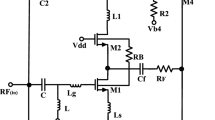Abstract
A 0.18 µm CMOS low noise amplifier (LNA) by utilizing noise-canceling technique was designed and implemented in this paper. Current-reuse and self-bias techniques were used in the first stage to achieve input matching and reduce power consumption. The core size of the proposed CMOS LNA circuit without inductor was only 128 µm × 226 µm. The measured power gain and noise figure of the proposed LNA were 20.6 and 1.9 dB, respectively. The 3-dB bandwidth covers frequency from 0.1 to 1.2 GHz. When the chip was operated at a supply voltage of 1.8 V, it consumed 25.69 mW. The high performance of the proposed LNA makes it suitable for multi-standard low-cost receiver front-ends within the above frequency range.








Similar content being viewed by others
References
Chang JH, Kim HJ, Choi JH et al (2010) A multistandard multiband mobile TV RF SoC in 65 nm CMOS. In: IEEE international solid-state circuits conference, pp 462–463
Bagheri R, Mirzaei A, Chehrazi S et al (2006) An 800-MHz-6-GHz software-defined wireless receiver in 90-nm CMOS. IEEE J Solid State Circuits 41:2860–2876
Moon H, Han J, Choi SI et al (2010) An area-efficient 0.13-µm CMOS multiband WCDMA/HSDPA receiver. IEEE Trans Microw Theory Tech 58:1447–1455
Kim H, Kang S, Chang JH et al (2010) A multi-standard multi-band tuner for mobile TV SoC with GSM interoperability. In: IEEE radio frequency integrated circuits symposium, pp 189–192
Yang GL, Liu F, Muhammad A et al (2013) 30–50 GHz high-gain CMOS UWB LNA. Electron Lett 49:1622–1623
Liu RC, Lin CS, Deng KL et al (2003) A 0.5–14-GHz 10.6-dB CMOS cascode distributed amplifier. In: Symposium on VLSI circuits, pp 139–140
Feng C, Yu XP, Lu ZH et al (2013) 3–10 GHz self-biased resistive-feedback LNA with inductive source degeneration. Electron Lett 49:387–388
Chung T, Lee H, Jeong D et al (2015) A wideband CMOS noise-canceling low-noise amplifier with high linearity. IEEE Microw Wirel Compon Lett 25:547–549
Oh NJ (2011) A low-power 3.1-10.6 GHz ultra-wideband CMOS low-noise amplifier with common-gate input stage. Curr Appl Phys 11:87–92
Li CH, Kuo CN, Kuo MC (2012) A 1.2-V 5.2-mW 20–30-GHz wideband receiver front-end in 0.18-μm CMOS. IEEE Trans Microw Theory Tech 60:3502–3512
Lu Y, Yeo KS, Cabuk A et al (2006) A novel CMOS low-noise amplifier design for 3.1- to 10.6-GHz ultra wide band wireless receivers. IEEE Trans Circuits Syst I 53:1683–1692
Yu YH, Yang YS, Chen YJE (2010) A compact wideband CMOS low noise amplifier with gain flatness enhancement. IEEE J Solid State Circuits 45:502–509
Chen KH, Liu SI (2012) Inductorless wideband CMOS low-noise amplifier using noise-canceling technique. IEEE Trans Circuits Syst I 59:305–314
Bruccoleri F, Klumperink EAM, Nauta B (2004) Wide-band CMOS low-noise amplifier exploiting thermal noise canceling. IEEE J Solid State Circuits 39:275–282
Belostotski L (2016) No noise is good noise: noise matching, noise canceling, and maybe a bit of both for wide-band LNAs. IEEE Microw Mag 17:28–40
Kim J, Hoyos S, Silva-Martinez J (2010) Wideband common-gate CMOS LNA employing dual negative feedback with simultaneous noise, gain, and bandwidth optimization. IEEE Trans Microw Theory Tech 58:2340–2351
Liao CF, Liu SI (2007) A broadband noise-cancelling CMOS LNA for 3.1-10.6-GHz UWB receivers. IEEE J Solid State Circuits 42:329–339
Blaakmeer SC, Klumperink EAM, Leenaerts DMW et al (2008) Wideband balun-LNA with simultaneous output balancing, noise-canceling and distortion-canceling. IEEE J Solid State Circuits 43:1341–1350
Kim J, Silva-Martinez J (2012) Wideband inductorless balun-LNA employing feedback for low-power low-voltage applications. IEEE Trans Microw Theory Tech 60:2833–2842
Acknowledgements
This work was supported by the National Science & Technology Major Projects (No. 2012ZX03004008), by the National Natural Science Foundation of China (No. 61376082), and by the Tianjin Natural Science Foundation (No. 13JCZDJC25900).
Author information
Authors and Affiliations
Corresponding author
Rights and permissions
About this article
Cite this article
Qin, G., Jin, M., Tu, G. et al. Inductorless CMOS Low Noise Amplifier for Multiband Application in 0.1–1.2 GHz. Trans. Tianjin Univ. 23, 168–175 (2017). https://doi.org/10.1007/s12209-017-0040-7
Received:
Revised:
Accepted:
Published:
Issue Date:
DOI: https://doi.org/10.1007/s12209-017-0040-7




